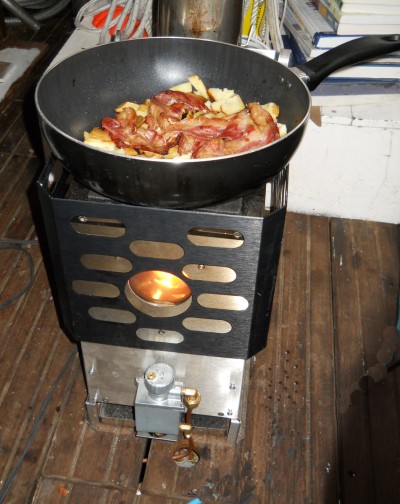 The heating system on Issuma consists of two drip-pot diesel heaters. The pilothouse is heated by a Dickinson Lofoten heater, which is also used for cooking (though most cooking is done by a gas stove/oven). The forward part of the boat is heated by a Dickinson Alaska heater (see previous blog entry). Fuel for the heaters is gravity-fed from the daytank, through a fuel filter/water separator. The drip-pot diesel heaters will not run if there is water in the fuel. A little water in the fuel will result in it boiling loudly as it enters the combustion chamber, and the heater might stay running, but with a lot of water in the fuel, the flame will go out, and the regulator needs to have the water removed from it (there are no drain plugs, so the way I’ve done this is to suck it out with a copper tube). Between these two heaters, the inside temperature can be about 25 degrees C higher than the outside temperature, or about 20 degrees higher if it is windy. This works well down to about -10C/14F (and not so well at -20C/-4F). Previously, a wood stove was used. This put out a decent amount of heat, but had to be tended every hour or two, so, over the course of 24 hours, didn’t put out as much heat as a diesel heater did. The wood stove was more suitable for heating when there are several people aboard, to share the task of tending the stove.
The heating system on Issuma consists of two drip-pot diesel heaters. The pilothouse is heated by a Dickinson Lofoten heater, which is also used for cooking (though most cooking is done by a gas stove/oven). The forward part of the boat is heated by a Dickinson Alaska heater (see previous blog entry). Fuel for the heaters is gravity-fed from the daytank, through a fuel filter/water separator. The drip-pot diesel heaters will not run if there is water in the fuel. A little water in the fuel will result in it boiling loudly as it enters the combustion chamber, and the heater might stay running, but with a lot of water in the fuel, the flame will go out, and the regulator needs to have the water removed from it (there are no drain plugs, so the way I’ve done this is to suck it out with a copper tube). Between these two heaters, the inside temperature can be about 25 degrees C higher than the outside temperature, or about 20 degrees higher if it is windy. This works well down to about -10C/14F (and not so well at -20C/-4F). Previously, a wood stove was used. This put out a decent amount of heat, but had to be tended every hour or two, so, over the course of 24 hours, didn’t put out as much heat as a diesel heater did. The wood stove was more suitable for heating when there are several people aboard, to share the task of tending the stove.
Monthly Archives: February 2011
Forward Heater
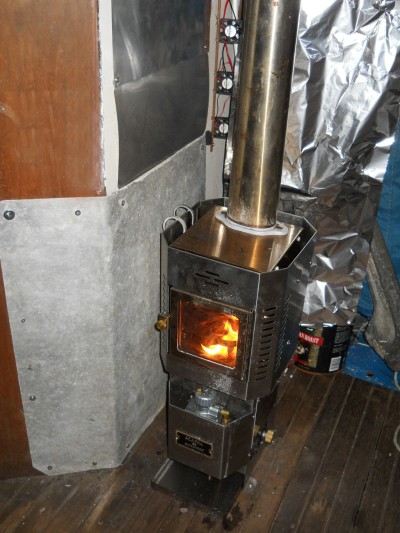 The Dickinson Alaska heater in the forward part of the boat. This heater puts out about half as much heat as the Lofoten heater in the pilothouse. There are 24 volt (Issuma’s electrical system is 24 volt) computer fans on the wall that blow the warm air off the chimney into the boat. The plywood wall is covered with sheet aluminum to keep heat away. A strip of aluminum foil is hung from the ceiling to reflect heat back into the main part of the boat (this is only used on cold days in the winter at the dock). Not shown in the picture is a barometric damper, which injects room air into the chimney, so less heat is wasted going up the chimney and out of the boat. Putting in the barometric damper made the heater put 30-40% more heat in the boat than it did when running without the barometric damper (this is partly because there is a tall stack–about 3m in total). To be installed soon is a grating that protects things from touching the hot chimney.
The Dickinson Alaska heater in the forward part of the boat. This heater puts out about half as much heat as the Lofoten heater in the pilothouse. There are 24 volt (Issuma’s electrical system is 24 volt) computer fans on the wall that blow the warm air off the chimney into the boat. The plywood wall is covered with sheet aluminum to keep heat away. A strip of aluminum foil is hung from the ceiling to reflect heat back into the main part of the boat (this is only used on cold days in the winter at the dock). Not shown in the picture is a barometric damper, which injects room air into the chimney, so less heat is wasted going up the chimney and out of the boat. Putting in the barometric damper made the heater put 30-40% more heat in the boat than it did when running without the barometric damper (this is partly because there is a tall stack–about 3m in total). To be installed soon is a grating that protects things from touching the hot chimney.
Channel Entrance
Toronto, Canada
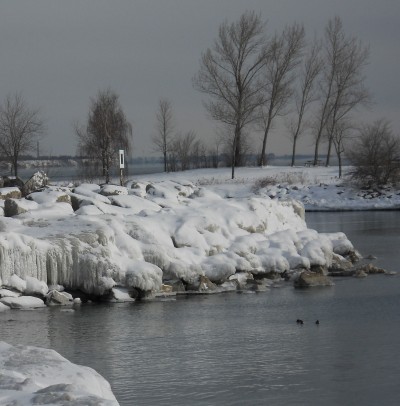 The entrance to the harbor Issuma is in is to the right of the green daymark
The entrance to the harbor Issuma is in is to the right of the green daymark
Channel Marker
Toronto, Canada
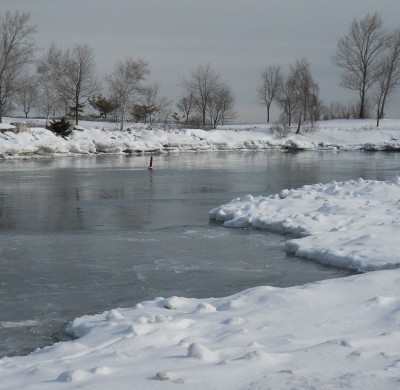 The red nun buoy in this picture is much easier to recognize than the one in yesterday’s picture that was loaded with ice. This buoy is around a bend in the channel, so it doesn’t get the breaking waves that the outer buoy does…I believe that is why it is not covered in ice. This part of the channel still gets swell coming in, which breaks up the ice.
The red nun buoy in this picture is much easier to recognize than the one in yesterday’s picture that was loaded with ice. This buoy is around a bend in the channel, so it doesn’t get the breaking waves that the outer buoy does…I believe that is why it is not covered in ice. This part of the channel still gets swell coming in, which breaks up the ice.
Channel Marker
Toronto, Canada
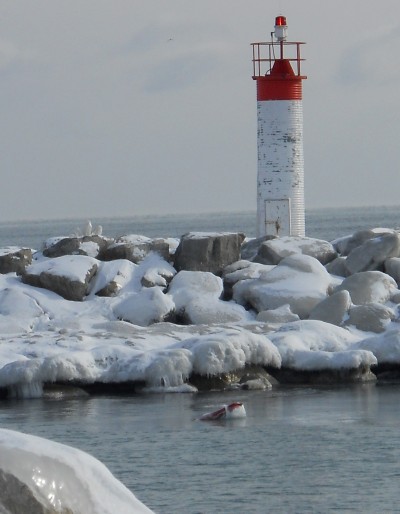 Below and to the left of the lighthouse, what looks like a floating piece of ice is actually a red nun (buoy with a pointed top), marking the entrance channel to the harbor.
Below and to the left of the lighthouse, what looks like a floating piece of ice is actually a red nun (buoy with a pointed top), marking the entrance channel to the harbor.
Gale
Toronto, Canada
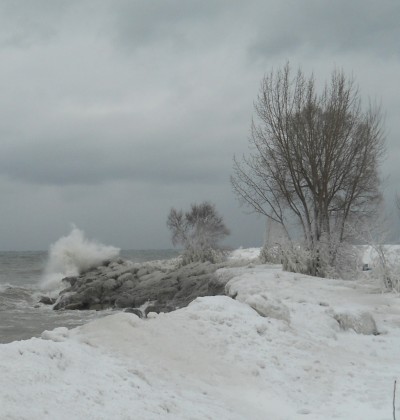
Gale
Toronto, Canada
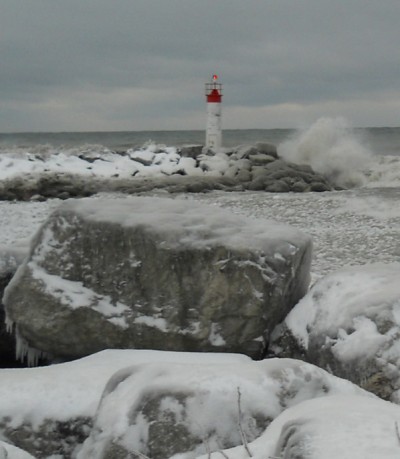 It warmed up to -10C (14F) and got windy last night and this morning. This is the entrance to the harbor where Issuma is. The waves broke up the ice a fair way into the harbor, but not as far as Issuma, which is still frozen into the ice.
It warmed up to -10C (14F) and got windy last night and this morning. This is the entrance to the harbor where Issuma is. The waves broke up the ice a fair way into the harbor, but not as far as Issuma, which is still frozen into the ice.